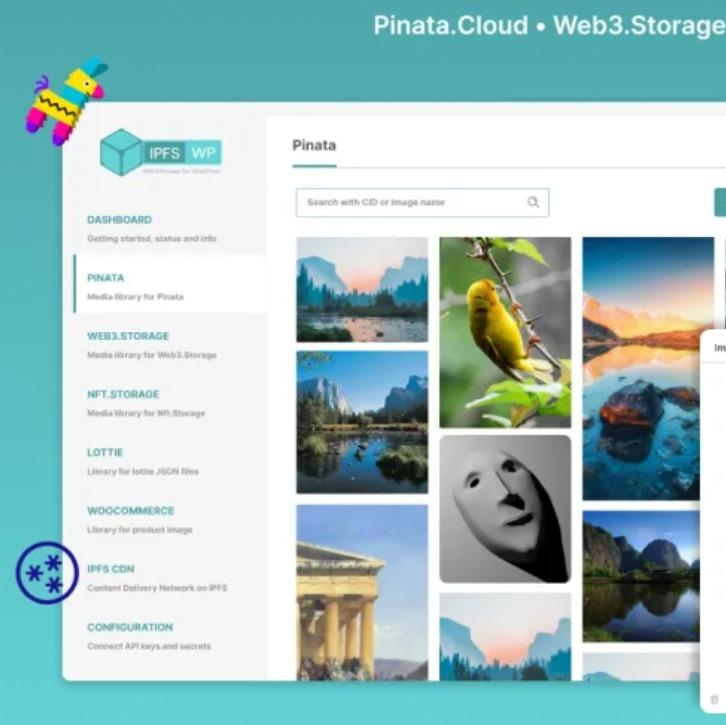IPFS for Wordpress
IPFS for Content management system.WordPress is a free and open-source content management system written in hypertext preprocessor language and paired with a MySQL
Created on 26th March 2023
•
IPFS for Wordpress
IPFS for Content management system.WordPress is a free and open-source content management system written in hypertext preprocessor language and paired with a MySQL
The problem IPFS for Wordpress solves
What if everyone can now easily implement IPFS solutions on their websites? Especially on the world's largest WordPress CMS which powers 34% of all websites on the Internet. This will absolutely change the game!
With The advent of NFT boom created a huge history in the blockchain space. That was the first time I came across IPFS (a protocol and peer-to-peer network for storing and sharing data in a distributed file system) as it was the most used technology for storing and addressing NFTs data. At that time, I was also introduced to the IPFS storage and pinning tools which build on this large network, such as Pinata, Web3.Storage, Nft.Storage etc. However, the status quo is that the utilization of IPFS is still limited. I started to dive deeper and spend lots of time learning them. Throughout this journey, the term "Web3.0" grew famous in the blockchain realm, and a lot of resources were flooding into this sector, hoping for a paradigm shift to the Web3 era.
Focusing on producing Web3 products, in my opinion, is not the best strategy to change the way the Internet operates as a whole. Instead, we must devote greater resources to building and integrating Web3 features and technologies into the present Web2 environment.
🔻 The Solution
Hence, I designed and built the first most powerful and comprehensive IPFS plugin for the WordPress CMS, which provides various IPFS solutions for WordPress site. Everyone can now install it on their WordPress site and start to integrate IPFS features easily, as well as manage everything just by using one admin panel. I believe that if a technological product has a low barrier to entry, it may have a significant influence in its domain. This is exactly what this plugin, "IPFS for WordPress" is currently doing - making a huge impact by providing IPFS solutions (Web3.0) on WordPress CMS (Web2.0) in a user-friendly way, accelerating the shift to the Web3.0 era.
How powerful is the plugin? | Features Overview
Here is a features over
Challenges I ran into
The greatest challenge is when the IPFS-retrieved images can't be processed by the WordPress built-in image generation system and were having trouble generating different sizes of images to use on different locations on the website. This had heavily affected the integration of IPFS and WooCommerce, as well as some of the other features in the plugin.
However, when God closes a door, he opens a window to explore. We had successfully built our IPFS image generation system to replace the default WordPress image generation system. Now, when users retrieve images from the IPFS storage tools, the IPFS image generation system will automatically generate different sizes of images, pack them into a folder, and upload them back to the IPFS network. The WordPress database will also store the generated images' CIDs and keep track of them for future use. Furthermore, because of the IPFS image generation system, users can now choose the image size displayed for the IPFS image block in Elementor. The thumbnail system for all of the IPFS media libraries in the plugin also benefited from the IPFS image generation system .I discovered numerous possible IPFS use cases on the WordPress CMS and successfully
Images stored on IPFS storage tools can be directly imported into the WordPress CMS for site-building, and even have respective media libraries to manage these media assets.
Switching image assets from traditional WordPress media storage to the IPFS network is now hassle-free, user-friendly, and less time-consuming. Just a few simple clicks!
One of the most popular WP website builders, Elementor has a library of IPFS building blocks to easily integrate IPFS solutions in a less-code/no-code site-building environment
WooCommerce can now integrate with IPFS to support and power an eCommerce store with many products while just needing small server
IPFS Content Delivery Network for WordPress become a powerful cost-friendly alternative solution for WordPress sites to implement CDN
Tracks Applied (1)
Best use of decentralized storage using filecoin
Filecoin
Technologies used
